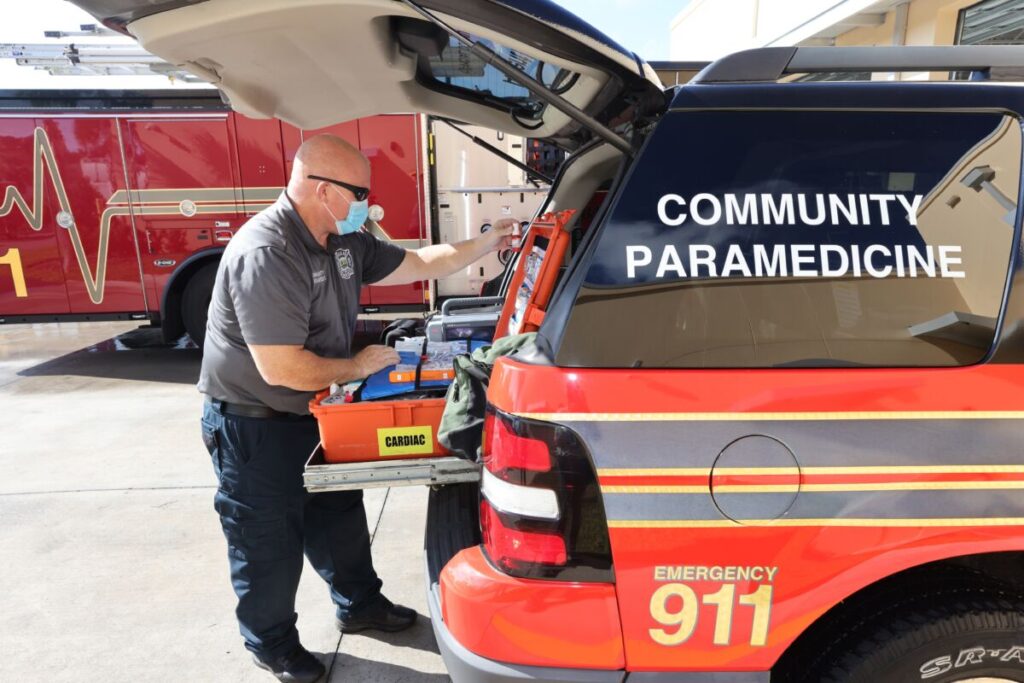Marion County’s new paramedicine program

Capt. Chris Hickman checks on the inventory of medications in the Ocala Fire Rescue/AdventHealth Community Paramedicine unit at Ocala Fire Rescue Headquarters on Northwest Martin Luther King Avenue in Ocala, Fla. on Wednesday, Sept. 15, 2021. [Bruce Ackerman/Ocala Gazette] 2021.

Capt. Chris Hickman checks on the inventory of medications in the Ocala Fire Rescue/AdventHealth Community Paramedicine unit at Ocala Fire Rescue Headquarters on Northwest Martin Luther King Avenue in Ocala on Sept. 15. [Bruce Ackerman/Ocala Gazette]
The origin story
Ocala Fire Rescue began their community paramedicine program in April of 2020 in partnership with Advent Health. Ocala Fire Rescue EMS Captain Jesse Blaire heads up the OFR portion, and he said when they were coordinating and designing the program, he reached out to multiple agencies around the state to observe similar programs.
“We spoke to several different people,” he says. “West Palm Beach, Manatee County, Gainesville Fire Rescue.”
Blaire said because community medicine programs are so unique to the areas they serve, that “if you’ve seen one community medicine program, you’ve seen exactly one community medicine program. The people, the stakeholders, the hospitals. All that makes each program very specific to that area.”
MCFR Deputy Chief for Operations Robert Graff agreed. “We have 1,600 square miles in Marion County and based on the type of services that community paramedicine programs offer across the country there’s so many different ways the program can be used here in Marion County,” he points out.
“My biggest concern was how was I going to identify the most important thing to start with and then grow it from there,” Graff says.
Starting out, Blaire noted, there were some learning curves. These included not realizing homebound patients lacked transportation or sometimes even the motivation to get prescriptions filled. In some cases, literacy levels were an issue.
“But, since then, the whole continuum of care has made incredible progress,” says Blaire.
Wanda Bowlin is the EMS coordinator and Emergency Management specialist for Advent Health and is the point of contact within Advent for the community paramedicine program.
She said, early on, figuring out which patients would benefit from enrollment in the program was a challenge.
“The biggest difference for us is the referral practice. In the beginning we were kind of struggling on basically kind of vetting what patients are appropriate for community paramedicine because we wanted to do the most we can, and we wanted to work together to help our community to find the right care.”
Bowlin remarked that the existing relationships between the stakeholders made beginning the program a bit easier. Because OFR, Advent, and MCFR all have established ties with one another, they could seek out additional ways the program could assist those enrolled by involving other community partners.
“We’ve not only met with each other but looked at a lot of resources within the community,” Bowlin says. For example, “…when the community paramedics go out and let’s say they’re seeing a patient specifically for a new onset [illness]. They also are basically doing an evaluation, kind of a social determinants evaluation. Are there other things, food insufficiencies, do they need assistance with their prescriptions, can we get out some discounts or prescription coupons, and do they have different kinds of social barriers or personal barriers that are preventing them from caring for themselves?”
Blaire noted Advent’s resource list is used often when OFR interacts with the patients in the program to direct them to the additional resources within the community.
“So now we encounter that person, oh you can’t read, no problem. We’ve got the literacy council; we’ve got United Way; we’ve got all these different things already set up ready to rock and roll,” he says.
“There’s tons of resources locally,” Bowlin points out. “It’s just connecting people with the proper resource so that we can take care of that whole person.”
Getting the program started with the county
At the Aug. 17 MCBOCC meeting, MCFR received approval on a grant agreement with Advent Health Ocala and The Community Foundation for Ocala/Marion County aimed at expanding a community paramedicine program that began in April of last year.
At the Sept. 14 meeting, the MCBOCC additionally approved the creation of two positions for the program, allowing MCFR to begin their arm of the program.
The paramedicine positions with both MCFR and OFR are funded by a grant from Advent Health, so the program comes with no cost to the city or the county, except incidental costs.
Graff was excited to get their portion of the program started and appreciated the ability to make the program their own.
“I knew from the beginning it was a needed project and so the intention was to get it up and running and keep it going,” he says.
“We appreciate the support we’ve gotten from the board, from our fire chief, and the county engineer. They gave me the freedom to take the program and just run with it.”
Bowlin says the hope is to help break the cycle of individuals winding up in the emergency room for non-emergent reasons.
“It was just a matter of creating that partnership so we really could access those high vulnerability patients and be able to create a program where we can help them to be able to not only provide a level of self-care that they need once they’re discharged from the hospital, but also to help prevent them from having to re-admit, and to kind of guide them through their new diagnosis,” she states.
Graff echoes those sentiments. “[our community paramedics] are going to do patient assessments, they are going to look for trends, they’re going to identify and educate the citizens on the disease process that they are currently dealing with or post recovery for a procedure may be that they had. They’re going to spend quite a bit of time educating and then doing assessments, and then connecting them with resources if they need additional resources.”
That geographical boundaries will be less of an issue to delivering needed care is also exciting to Bowlin.
“Instead of having to be isolated to just a certain part of the city, now we’ll be able to refer patients that live out in the rural areas and out further in the county into Marion County’s program. They’ll be able to pick up the ball with the same intent and take it to those patients that don’t have the access and maybe aren’t close enough for the city guys to see them,” she said.
Graff said the addition of the program, which they started gearing up for earlier this year, has been fairly seamless, and thinks he knows why.
“Honestly, we have great support from our commission, we have great support from our Fire Chief, and we have great support from the employees who want to be part of it,” he says. “So honestly, it was probably one of the easier projects I’ve ever had to work on. Everyone had a true passion for what we were doing, and we were able to identify the need and start making things happen.”
The program and getting patients enrolled in it
The majority of patients in the community paramedicine program are identified before they leave the hospital. Bowlin described the process of how they identify who would be a good fit, and the ideal patient for the program.
Perhaps a patient comes through the ER. “So, if someone identifies a patient… notices that this individual is here multiple times throughout the week. Maybe it’s because they don’t have access to their medication, or maybe because it’s a new diagnosis, then that’s the kind of patient that we’re looking for…or if it’s an impatient, then we have part of Advent that sees every patient prior to discharge and they really identify ‘hey, this is a new diabetic patient, they can really benefit from someone walking them through this transition to make sure they understand the importance of checking their blood sugar, medication compliance, attending their appointments.’”
Not all patients are enrolled in the program though the hospital, however. Blaire described how an individual can get involved without going through the hospital.
“We have this thing called Ocala Safe Stations. There’s a there’s a sign out front of every fire station, letting them know it’s a safe station where anyone with any addiction can come to any fire station and get treatment right now…if you’re overwhelmed, anxious, or maybe addicted, you can come to a fire station and get the help that you need right now.”
Graff believed the program allows those enrolled to know that someone is there for them, and that understanding is a relief to the patients.
“It gives them somebody they know they can count on, that they can reach out to if they have any issues because they can keep the dialogue open,” he says.
Bowlin agreed and said that dynamic between the programs was evident early on.
“Sometimes in the beginning it was ‘how many people would really be interested?’ but people are very grateful for the opportunity to have someone, especially with a new diagnosis. A lot of times people are scared, and we just want to be there to support that individual, and sometimes even their family members. Through this process we can give them kind of the support they need through this time”
Even though MCFR’s program has only been operational a short time, Graff noticed those who over utilize emergency services was their primary market.
“Our frequent system utilizers are who drove the beginning of the program. And…people who would call 911 after having a medical procedure. If they’re gonna use the 911 system and it’s not necessarily an emergency, we want to catch them before they make that that 911 phone call and we can get them the help they need prior to using the 911 system.”
And depending on how sick the patient is, Blaire said, affects how often the community paramedics interact with them.
“Based on the patient’s acuity there’s some people we see three times a week, some we see two times a week.”
Blaire also pointed out that diabetes, congestive heart failure, and COPD are the most common chronic illnesses they see. He also sees aspects of mental health issues as well in the patients they interact with.
When patients are newly diagnosed with a chronic illness, Bowlin said, there is also a laundry list of considerations tagging along with the news.
“Usually with a new diagnosis of a chronic illness comes medication education, follow-up appointments, medication compliance for patient, so they can learn why it’s so important that they take those. [For many] with new diagnoses, if they really don’t learn and follow the program, they need to be able to live with that chronic diagnosis, then they kind of get themselves into an emergency situation. That’s usually how they end up back in the ER. So those are usually the patients we have identified that seem to frequently benefit and that we can see the patient, work them through those three steps, and successfully graduate.”
And in order to graduate, noted Blaire, the patients must show improvement in how they handle their medical conditions.
“We require that they make progress, and we hold them to some sort of a standard. We have expectations that they’re going to do what we taught them to do.”
Blaire explained how the program is structured and how patients move through it. The program is phased.
“Phase one is meeting and understanding the patient. Phase two…it’s like a SWOT analysis. Phase three, we kind of take a step back and watch their progress…once they master phase three, they graduate.”
Bowlin stated that when patients complete the program, they’re learning more than just about their new diagnosis or medication, but how to care for themselves.
“A lot of times we see them for this new onset diagnosis but were able to help them in so many other ways improve their life tenfold. It’s really rewarding to see the progress, to watch the people as they’re learning to self-care.”
“It usually takes a couple of visits to get to know what their problems are,” Blaire describes. “It takes about a week and a half to two weeks to teach them what they need to do. And then we watch them for at least a week, usually two weeks. And so, the minimum stay in our program is 30 days, the maximum is 90 days.”
Most people stay between 45-60 days. “We have some people who are recycled,” Blaire say. “Their needs are just overwhelming, so we graduate them automatically at 90 days knowing that next time they go to the hospital, which is probably tomorrow, they’ll be referred right back to program.”
A great partnership
Graff, Bowlin and Blaire all stressed how important the relationships between Advent, MCFR and OFR were, and how each organization has worked well with the others.
“We have wonderful relationships with Ocala Fire Rescue, as well as Marion County,” Bowlin says.
“We all work very well together to care for this community, so I have no reservations whatsoever. I work with these guys on a daily basis, and I appreciate all of them and I am happy to be a part of it,” she said.
“They’ve [Advent Health] been a fantastic partner,” added Blaire.
Bowlin believed it was because all those involved shared a common purpose.
“When you get down to it, we all have the same goal. We’re here to help individual just work into this news place in their life.”
Graff heartily agreed. “You know it’s great when you have a team working toward a common goal and everybody is on the same page, and everybody wants to achieve the same outcome.”
Room to grow
Despite being in its relative infancy in Ocala and Marion County, all the stakeholders involved are optimistic about the program and the care it can deliver.
One means of delivering care they have utilized is telehealth, or virtual care.
Blaire described how former Ocala Fire Chief Shane Alexander’s relationships with other city departments enabled OFR to begin to offer telehealth. Alexander coordinated with the Ocala Police Department so that when OPD upgraded their cell phones every couple of years, the old ones and their chargers were sent to OFR to be used in the program.
Bowlin also mentioned how Advent was able to secure iPads through a grant program so the community paramedics will have a virtual connection to providers and clinicians should they need to use it.
Each of the stakeholders involved is already looking ahead to how the program can be further developed.
“We aren’t ruling out growth,” Blaire declares. “We want to get really good that what we’re doing now and then think about expanding.”
Bowlin is anxious to grow the program as well. “I’m really excited that we’re able to expand and offer the service to more people.”
Even though MCFR is just getting their program underway, Graff, too, is eager for the program to grow.
“I plan to put another unit in service with two more people on it as fast as I can get it up and going. We currently run six battalions, and we’d like to have one in each battalion. That way, geographically, they can serve the community and it would cut down on travel time.”
Blaire pointed out the fiscal savings the program brings, but he said the cost savings are only part of how the program benefits the community.
“We save about 60 EMS responses per quarter, so that’s 240 calls a year. A call costs $750. That’s a yearly savings of $180,000…but what a lot of people don’t understand is the cost of not doing anything far, far outweighs whatever you would spend right now.”





